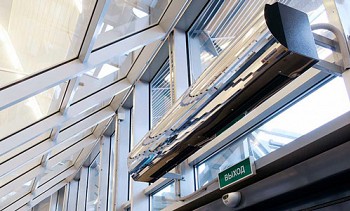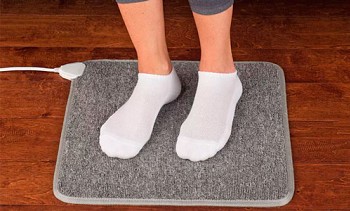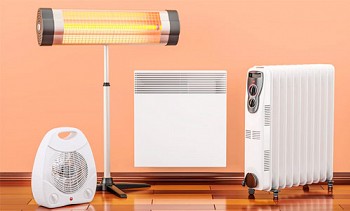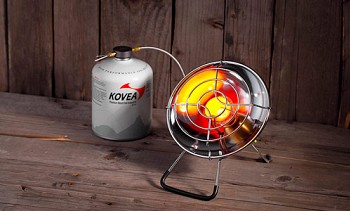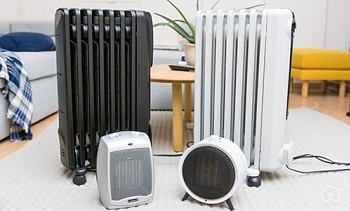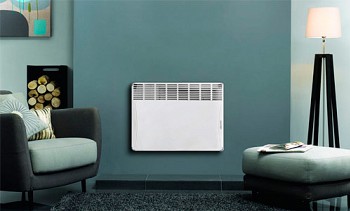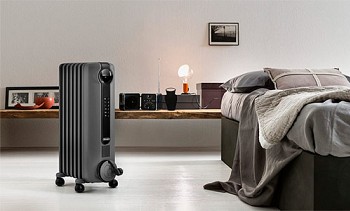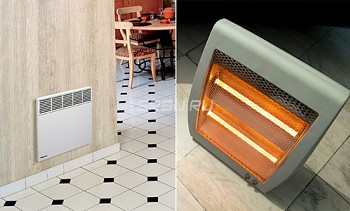What is better convector or oil heater - comparison of characteristics
Very often in everyday life use heaters or oil type, or convector. In general, the principle of heating the air masses is one (convection), but at the same time, warm air moves in each of the heaters in different ways. Many before buying a device for heating a room wonder: what is better than a convector or an oil heater. Therefore, let's weigh all the advantages and disadvantages of each of these devices and try to draw objective conclusions.
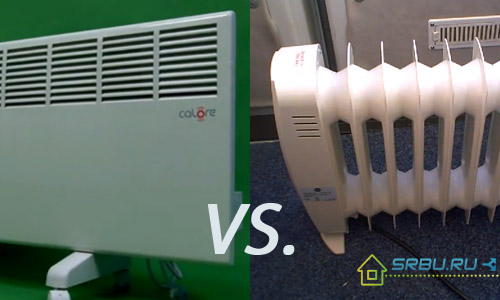
Content:
Oil type heaters
These devices are very widely used to increase the temperature in an apartment or house. Installing them is extremely simple, for this you do not need any special skills and knowledge. I plugged the device into a power outlet, placing it closer to a heated place - and you're done. Due to the simplest design, electrical circuit breakdowns are unlikely.
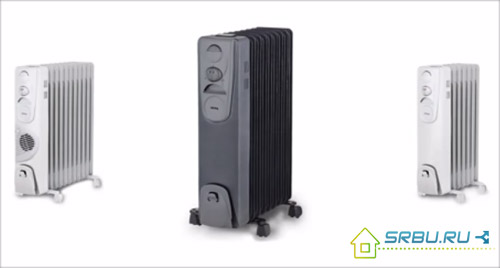
Several models of oil coolers - the far left is equipped with a fan.
The design of the oil cooler is based on a reservoir of metal with mineral oil poured into it. In the oil, in turn, is an element for heating. Typically, a device of this type is equipped with a rheostat for adjusting the temperature, a compartment for the power cord and electrical protection against overheating. Sometimes in the heater there is also a sensor that determines the deviation from the horizontal. This allows you to automatically turn off the tipping device. Oil radiators also provide splash protection.
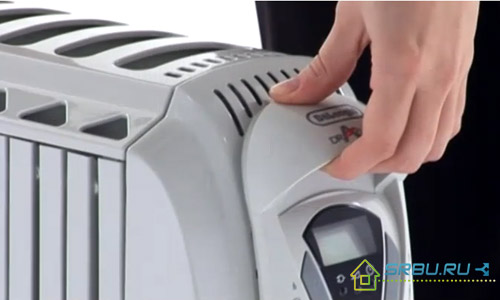
Oil radiators are equipped with a handle for convenient movement around the apartment.
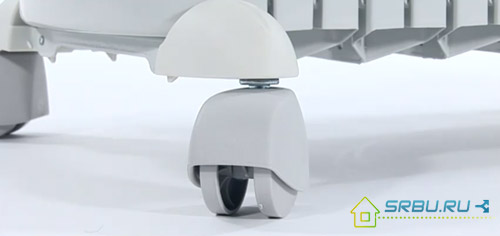
Heaters are equipped with swivel wheels.
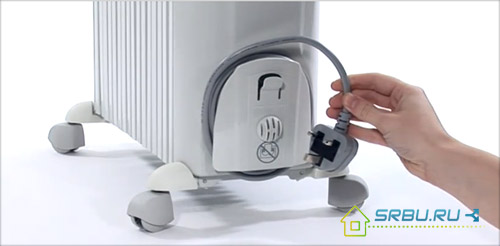
Compartment for the cord, designed to store the power cable inoperative.
Advantages of the oil device:
- Low price;
- Silent work;
- Ease of movement at various distances, for example, from room to room.
To determine how much power the device will need in order for the room to become warm, we use the following rule. If the ceiling height does not exceed three meters, then for heating 10 square meters of a room you need a radiator with a power of 1 kilowatt. Basically produce similar devices with a power range from 1 to 2.5 kilowatts.
The appliance usually has a thermostat, which automatically sets the desired temperature, maintaining it at the same level. The models equipped with a timer are very convenient - it will turn on the heater at the appointed hour. For example, you can plan heating in the morning or evening, when all households come home from work. Thus, the timer allows you to save a fair amount of electricity, which costs today oh how expensive.
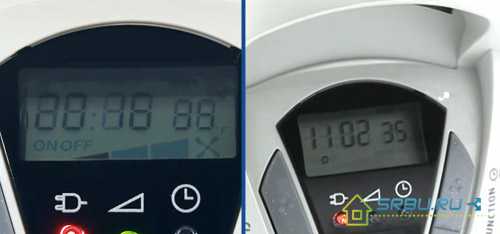
Heater with electronic control system.
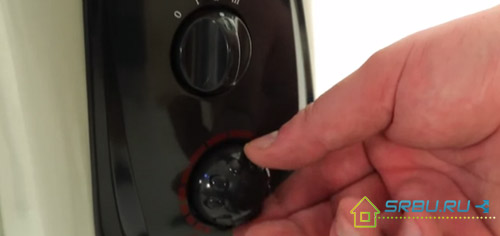
Mechanical control system.
Convection type heaters
They differ from oil radiators in the shape of the case - they have it flat and smooth. It has a room thermostat, thanks to which the desired temperature is maintained in the room.
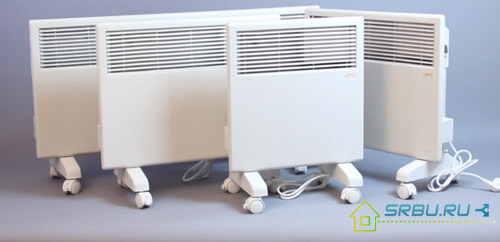
Simple convector heaters in a classic design.
Unlike oil heaters, which are mainly floor-mounted, convector radiators are mainly fixed to the walls. But there are also floor models - usually they have wheels for movement.
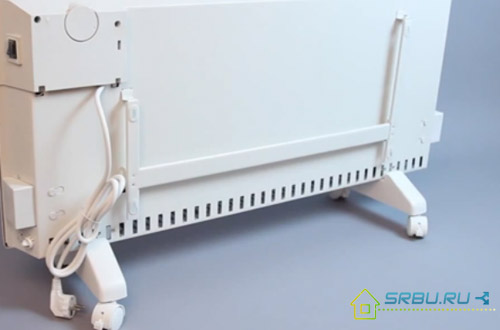
A convector having fastenings and can either be hung on a wall or mounted on wheels.

Skirting convectors, with a height of 15 cm and a length of 1,500 cm.
Oil heaters radiate heat. Convectors have minimal heat radiation - just from the front panel. And air heating occurs due to the exchange of heat of cold and hot air masses. In this case, there is a constant movement of air along the surfaces of the heater.
Convectors do not make any noise, their work is based on a natural process - air convection. They quickly and evenly warm the room. Mounting the device on the wall is easy and simple, and if desired, you can install it on the floor. There are convection heaters for both home and office, commercial or industrial premises.
In a convection device, air moves, moving to different heights. Hotter, more rarefied, air flies up to the ceiling, and heavy cold air tends down to the floor. If convection occurs correctly, then constantly flows of air masses that heat the room.
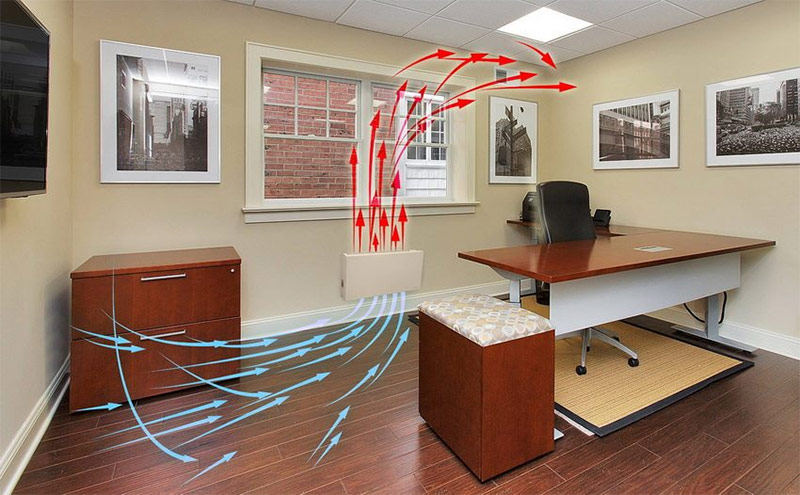
This is how air masses move during convection.
The device consists of the following elements:
- Convection chamber (heater body);
- Heating element integrated in the housing.
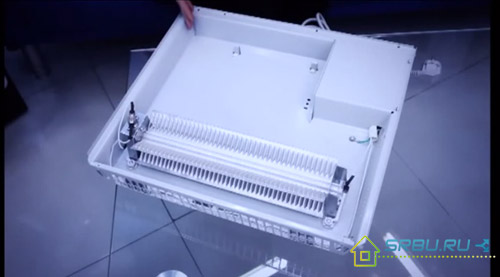
Convector heater with front cover removed.
During operation, cold air entering the convector is heated with the help of PETN. The air becomes lighter, it rises and exits through the upper blinds. Well, and in place of the cold air of the room that went up, a new portion comes.
The heated air has a temperature set on the thermostat. He then turns off, then turns on the heating element. The efficiency of this device is very high. The slots located on the front panel are designed to let out hot air. So that he does not move directly up, but heats the floor and walls, the blinds for his exit are directed down. Air does not come out immediately, but accumulates inside and gets excessive pressure. After that, he leaves the device in a horizontal direction.
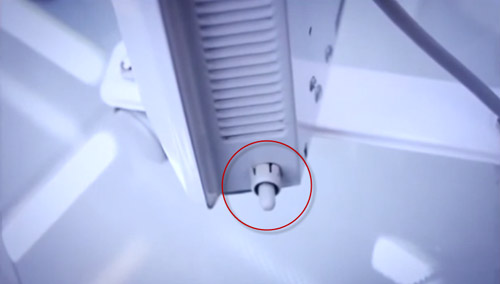
Thermostat convector heater.
Since the heating element is specially fixed in the housing, you do not have to worry about grounding. After all, ten has no contact with the metal of the body - between them are stops made of special heat-resistant plastic. And structurally, the device is made in such a way that the heat in the room is distributed evenly. This provides coziness and comfort.
For those who cannot decide what to buy a convector or an oil heater, it will not be out of place to know about the advantages of convector heaters:
- These devices are fireproof and meet the requirements of the European standard.
- Such heaters placed in each room and combined into one network can get a modular heating system. In a country house or in a country cottage, it can very well be used instead of a boiler, which is expensive and requires the installation of numerous heating pipes,
- Thanks to the electronic thermostat and various operating modes, electricity can be significantly saved.
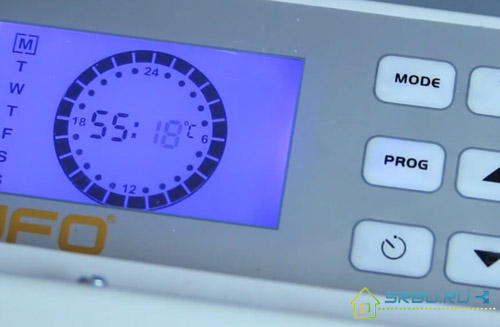
Electronic control system and on-off timer.
Convector and oil heater - comparison reveals the undoubted leader
So, let's compare the main indicators of the two most popular heaters.
1. Profitability of use. An oil cooler consumes a quarter more electricity than a convector. Since electricity tariffs are constantly growing, this fact may be decisive when choosing a device.
2. Warm up time. Heating the air with an oil heater goes through several stages: first, the electricity heats the ten, then the ten - the oil, and it, in turn, heats the fins of the casing, which gives heat to the air masses. This takes a lot of time (and there is a lot of electricity) - the device has been turned on for a long time, and the cold is still in the room. Fans built into the oil heater can speed up the process.
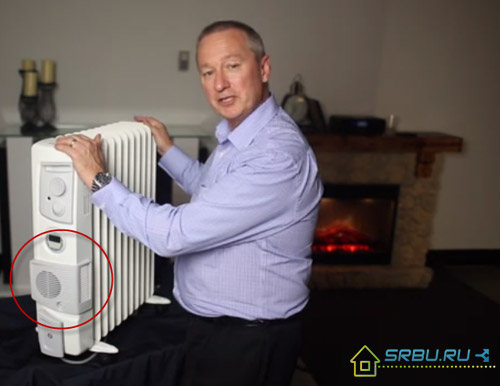
Oil type heater with integrated electric fan.
The convector heater immediately heats the case, so its efficiency is at least 95 percent.But the heating rate is also not so great and the oil cooler equipped with a fan, ceteris paribus, is likely to outperform the convector.
3. Comfort at work. This refers to the ease of carrying and installation. It should be noted that convectors in this regard are more convenient and more mobile. Their weight is not more than 10 kilograms, and oil devices are more bulky and heavy - their weight is from 18 to 25 kilograms. It is more convenient to move convectors on wheels and it’s easy to fix it to the wall, which will save space in the apartment and facilitate cleaning. In addition, the temperature created by the convector is more comfortable. It does not have swings throughout the volume of the room.
4. Security. You understand that hot oil is not the best neighbor. It heats the heater body so that it is not far from a burn. Exceptions are heaters equipped with a protective cover.
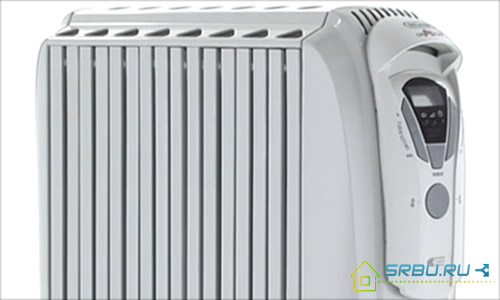
Radiator with a protective casing to protect against burns, which can be obtained by touching the red-hot radiator case.
But convection devices can be called absolutely safe. After all, their body is heated to only 60 degrees, and at this temperature it is impossible to burn yourself. Equipped with a protection function, a convector left unattended will not suit the owner. But the oil device must in no case be left alone with the room - after all, some of its models do not even have an overheating sensor.
5. Life time. Probably not one person witnessed the leakage of oil from the oil heater. Sooner or later, a leak appears. First, a microcrack appears on the body, then oil slowly begins to evaporate through it. Well, as a result, the heater fails, and no one undertakes to repair it - is it possible to find a tiny microcrack. As for convector heaters, they last for 10 and 15 years, although the manufacturer usually indicates the warranty period 5 years.
6. Environmentally friendly device. To begin with, we take it as an axiom that dust in a room will always rise when air moves during convection. Therefore, merchants lie, talking about some special models of convection or oil heaters that do not raise dust. Now about burning oxygen. For convectors, the peculiarity of the PETN material and the heating temperature of the body are such that this process is physically impossible. Some argue that oil radiators can still burn oxygen. Do not believe - this is not true.
Not a single heater burns oxygen - there is no open burning in them!
7. The cost of the device. Here, oil heaters are pulled ahead - their prices are significantly lower than for convectors. But do not forget about the ratio of price and quality, that is, to compare not only prices, but also the most important technical indicators (which were discussed above).
Comparison table of technical characteristics of oil and stove heaters
| Parameters | Oil heater | Convector heater |
|---|---|---|
| Cost-effectiveness | - Uneconomic. |
+ Approximately 25% more economical. |
| Heating time | +- Regular models heat up for a long time, and equipped with fans quickly. |
- Heats the room for a long time. |
| Comfort to use | - Average. |
+ Both floor and wall models are more convenient. |
| Security | - High surface temperature (but there are models with a protective cover); if the operating rules are violated, there is a risk of explosion. |
+ The surface of the convector is not exposed to strong heating; can be left unattended. |
| Life time | - Average |
+ Big |
| Environmental friendliness | - Convection raises dust particles |
- Convection raises dust particles |
And in the aggregate of all this, deciding what to choose a convector or an oil heater, we can definitely conclude: of course, a convector. Lightweight, compact, silent and safe, these heating devices are gradually replacing heavy, short-lived devices filled with hot oil from apartments and offices. So we can say that oil heaters have almost become yesterday in the matter of space heating.The only thing is that models of oil heaters equipped with fans are able to heat the room a little faster, but the process of heating its surface remains long. See below for detailed information on choosing these heaters.
Video: Convector or oil heater

